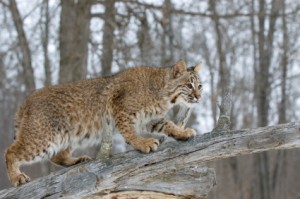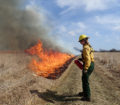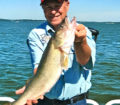Bobcats were found throughout Iowa at the time of European settlement. Although they were abundant in the early 1800’s, there was little evidence of bobcats in Iowa by the end of that century. In the 1930’s and 1940’s, bobcats were found very sparingly in all extreme corners of Iowa, but they were totally absent in the majority of the state. In 1977, the Department of Natural Resources (DNR) developed the first list of endangered and threatened species of Iowa, and the bobcat was then listed as endangered. The demise of bobcats in Iowa was a similar story to all other species that have vanished from the state, combination of over hunting and mostly the loss of habitat. The loss of habitat was caused by the changing landscape due to increased farming pressure.
For decades the bobcat has shown slow, steady expansion in Iowa. In 2001 bobcats were taken off of the endangered list and lowered to the threatened species roster. In 2002 and 2003, the number of sightings, road kills and incidental captures of the bobcat across the state led to the removal of the bobcat from the threatened list. It is estimated that there are about 1,500 to 2,400 bobcats inhabiting the southern two tiers of counties. There are no real estimates for the rest of the state
Bobcats have made their comeback in Iowa virtually on their own. The Iowa DNR has not engaged in any type of restoration program, such as release of animals in the State. They have only received protection from trapping, hunting and wanton waste.
The return of bobcats to Iowa is a result of many factors. Populations in surroundings states are growing and they are expanding their ranges looking for food. This expansion is coming mostly from Missouri. A main reason why bobcats are thriving in Iowa might be the grassland and brushy habitats created by the Conservation Reserve Program. These habitats provide suitable food resources such as small mammals and rodents for the bobcats to feed upon as well as use for den sites. Less human pressure on bobcats in states to the southwest of Iowa has also allowed bobcat numbers to increase in Iowa.
Due to the increase in the bobcat population in Iowa the DNR approved limited furharvester season for the 2007 season. The first bobcat season was for Iowa’s southern two tiers of counties only, Adams, Appanoose, Clarke, Davis, Decatur, Des Moines, Fremont, Henry, Jefferson, Lee, Lucas, Mills, Monroe, Montgomery, Page, Ringgold, Taylor, Union, Van Buren, Wapello and Wayne.
Legal means of harvest was by trapping or hunting. The open zone quota was 150 bobcats, plus any that were trapped in a 48 hour grace period after the quota was reached. The season was to run until the quota was filled or Jan. 31, 2008, whichever came first. The season limit was one bobcat per licensed furharvester, regardless if it was hunted or trapped. Hunters and Trappers were required to have a furharvester license and pay the habitat fee to trap bobcats, if normally required to have them to trap. A regular hunting license was not adequate.
The past 2011-12 bobcat season followed the same guidelines laid out for the inaugural season. The season ended on Nov. 28th when the new quota of 350 bobcats was reached. The past season saw the addition of Adair, Cass, Guthrie, Harrison, Keokuk, Louisa, Madison, Mahaska, Marion, Monona, Pottawattamie, Warren, Washington and Woodbury open to bobcat.
All bobcats harvested, either legally or accidentally, in Iowa must be reported to the area conservation officer within 24 hours. The officer will call the DNR’s Harvest Reporting System to report the animal. The DNR will post the quota remaining daily on their website and on a telephone hot-line. Once the quota is reached, trappers may keep any bobcat captured in the next 48 hours (grace period). Bobcats accidentally captured after the grace period and bobcats accidentally captured in an area of the state closed to bobcat harvesting, must be turned over to DNR without penalty. The website and hot-line will be updated daily to tell trappers when the season ends, when the grace period ends.
A special tag must be applied by the DNR before the bobcat is skinned and needs to remain with the animal until it is sold. Animals kept for taxidermy or other display or educational purposes must have the special tag retained with the pelt at all times. Bobcat carcasses are collected by DNR for study purposes.
Extensive population and reproductive studies conducted by the DNR has shown that the bobcatpopulation will continue to grow slightly or maintain current numbers given a trapping/hunting season. On average 100 bobcats per year are turned into the DNR due to accidental trapping.
Concerns by farmers about livestock loss in areas of heavy bobcat population are unwarranted. At this time there have been essentially no complaints about bobcats attacking livestock made to the DNR. Bobcats will on occasion eat livestock, especially sheep and chickens, although this is uncommon and the impact is generally minor. The main food source of bobcats is small mammals and rodents.


















Great article, very interesting
An informative read. Thank you.
Super article! I hope soon Plymouth County gets added to the list!